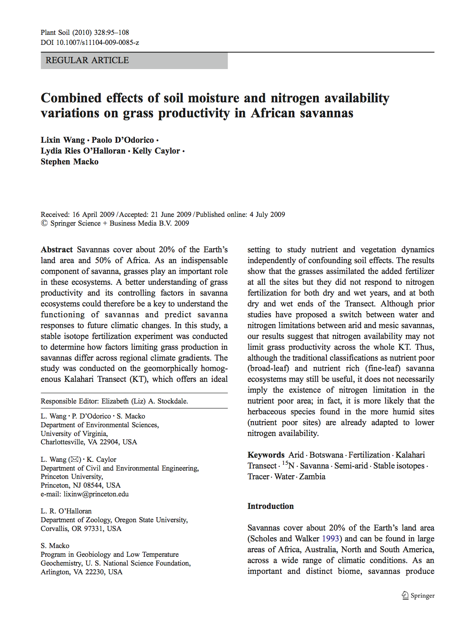Combined effects of soil moisture and nitrogen availability on grass productivity in African savannas

*Wang, L., P. D’Odorico, L. Ries, Caylor, K.K., and S. Macko (2010) “Combined effects of soil moisture and nitrogen availability on grass productivity in African savannas,” Plant & Soil, doi:10.1007/s11104-009-0085-z.
Savannas cover about 20% of the Earth’s land area and 50% of Africa. As an indispensable component of savanna, grasses play an important role in these ecosystems, and the dramatic grass expansion in Africa during the Miocene is closely linked to the origin of the modern savanna biome. A better understanding of grass productivity and its controlling factors in modern savanna ecosystems could therefore be a key to understanding the functioning of savannas and predict responses to future climatic changes. In this study, a stable isotope fertilization experiment was conducted to determine how factors limiting grass production in savannas differ across regional climate gradients. The study was conducted on the geomorphically homogenous Kalahari Transect (KT), which offers an ideal setting to study nutrient and vegetation dynamics independently of confounding soil effects.
The results show that the grasses did not respond to nitrogen fertilization for both dry and wet years, and at both dry and wet ends of the Transect. Although prior studies have proposed a switch between water and nitrogen limitations between arid and mesic savannas, our results suggest that nitrogen availability does not limit grass productivity across the whole KT. Thus, although the traditional classifications as nutrient poor (broad-leaf) and nutrient rich (fine-leaf) savanna ecosystems may still be useful, it does not necessarily imply the existence of nitrogen limitation in the nutrient poor area; in fact, it is more likely that the herbaceous species found in the more humid sites are already adapted to lower nitrogen availability.
